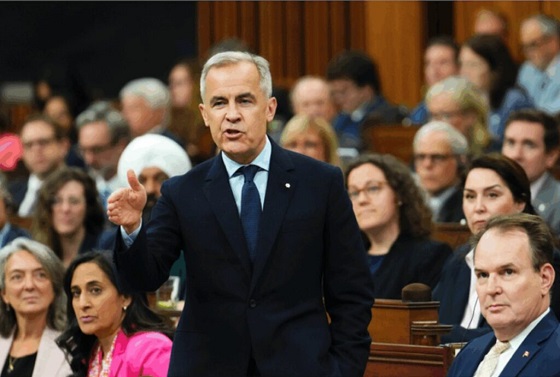Economy
The case against Net Zero 2050

Fossil fuels expert Alex Epstein shares everything you need to know about fossil fuels and what the world would really look like if we were “net zero” by 2050.
—
Alex Epstein is a philosopher and energy expert who argues that “human flourishing” should be the guiding principle of industrial and environmental progress. He is the author of the New York Times bestseller, “The Moral Case for Fossil Fuels,” and his latest book, “Fossil Future.”
For months I have been eagerly anticipating a scheduled debate I had at the University of Syracuse on “net zero by 2050” with climate catastrophist and net-zero advocate Tom Rand.
Unfortunately, due apparently to some sort of weird contractual issue between Tom’s agent and the university, Tom did not make it to the debate.
Since I was supposed to be in a debate, but there was no one to debate, I thought the best I could make of the situation would be to give a speech refuting every single argument for “net zero by 2050” that Tom and others make. It ended up being one of my favorite speeches ever; you can watch it here. We’ve also embedded the video below.
Below I have included all the “net zero” myths I covered , and then some. I think you’ll find them, along with the positive points about energy freedom, very valuable.
Myth: The best policy toward CO2 emissions is “net zero by 2050.”
Truth: Net-zero policies have been catastrophically destructive when barely implemented and would be apocalyptically destructive if fully implemented.
They should be abandoned in favor of energy freedom policies.
How to think about the right policy toward fossil fuels and their CO2 emissions
- What are “net zero by 2050 policies”?Government (coercive) actions whose primary and binding goal is the net-elimination of CO2 (and other GHG) emissions, whose number one source is fossil fuel use, by 2050.
In practice “net zero” means: rapidly eliminate most fossil fuel use.
- One “net zero” policy is an extremely high “carbon tax,” like “$1000/ton.”This would mean, in practice:
- 3-4 times higher prices for gasoline in Texas
- 9 times higher electricity prices in West Virginia
- 4-5 times higher prices for heating with natural gas
- What are “energy freedom policies”?Government actions to protect the ability of producers to produce all forms of energy and consumers to use all forms of energy, so long as they don’t engage in reasonably preventable pollution or endangerment of others.
- Energy freedom policies include:
- Protecting the freedom to develop fossil fuels and other forms of energy. E.g., deep geothermal development.
- Protecting the freedom to use fossil fuels and all other forms of energy. E.g., “decriminalizing nuclear.”
- Interesting: the 2 biggest instances of CO2 reduction have come from energy freedom policies:
- Nuclear: Freedom led to cost-effective and scalable nuclear power until the “green” movement virtually criminalized it.
- Gas: Freedom led to significant substitution of gas vs. coal.
- Myth: Net-zero policies are new and exciting.
Truth: Net-zero policies have caused catastrophic energy shortages even with minuscule implementation. Just by slowing the growth of fossil fuel use, not even reducing it, they have caused global energy shortages advocates didn’t warn us of. - Minuscule net-zero policies causing huge problems:
- US: Frequent power shortages (and some disastrous blackouts) after shutting down fossil fuel power plants. E.g., CA
- EU: Deadly fossil fuel dependence after restricting domestic fossil fuel industry
- Poor nations: Can’t afford fuel due to global restrictions1

- The root problem with “net zero by 2050”It violates a basic principle of rational thinking, which is that when evaluating what to do about a product or technology—e.g., prescription drug—you need to carefully weigh the benefits and side-effects of your alternatives.
- Myth: If there are negative climate side-effects of continuing fossil fuel use we should get them to net-zero as soon as possible.Truth: We should carefully weigh them against the benefits that come with them, including positive climate side-effects, climate mastery abilities, and many broader benefits.
- It is particularly crucial to weigh any negative climate side-effects of continuing fossil fuel use against the climate mastery benefits that come with them, as those benefits can neutralize or overwhelm negatives.E.g., more energy powering heating and cooling, irrigation, infrastructure-building, etc.
- Example of fossil-fueled climate mastery overwhelming negative impacts: Drought.Any contribution of rising CO2 to drought has been overwhelmed by fossil-fueled irrigation and crop transport, which have helped reduce drought deaths by over 100 times over 100 years as CO2 levels have risen.2

- An irrefutable method for thinking about policy toward fossil fuels and their CO2 emissions1 Factor in broad benefits
2 Factor in climate mastery benefits
3 Factor in positive and negative climate side-effects (from rising CO2)No net-zero advocate has refuted it, yet none follow it.
- How net-zero advocates fail to weigh benefits and side-effects of fossil fuels
- Factor in broad benefits – Deny or trivialize
- Factor in climate mastery benefits – Deny
- Factor in positive and negative climate side-effects – Deny or trivialize positives, Catastrophize negatives = Overstate, Deny mastery
- If we follow the irrefutable principles of weighing benefits and climate side-effects of continuing fossil fuel use, using undeniable facts and mainstream science, it is obvious that “net zero by 2050” would be apocalyptically destructive and that the right path forward is energy freedom.
Applying fossil fuel policy principle 1: Factoring in the broad benefits of continuing fossil fuel use
- Myth: The benefit of continuing fossil fuel use is trivial at best.Truth: The benefit of continuing fossil fuel use is a world in which 8 billion people have the energy they need to survive and flourish—vs. an energy-starved world in which most of the world’s 8 billion people suffer from poverty and premature death.
- Myth: There are no real benefits of continuing fossil fuel use because it can be rapidly replaced by mostly solar and wind.Truth: fossil fuels are and for decades will remain uniquely cost-effective: affordable, reliable, versatile—on a scale of billions of people in thousands of places.
- Myth: Fossil fuels are being rapidly replaced in an “energy transition” to solar and wind.Truth: Fossil fuel use is 80% of the world’s energy and still growing despite 100+ years of aggressive competition and 20+ years of political hostility and massive solar and wind favoritism.3

- Myth: Fossil fuel use will soon rapidly decline because countries know “green” energy will be cheaper.Truth: Countries that care most about cheap energy are pro-fossil fuels.
E.g., China, which uses mostly coal to produce “green” tech, has over 300 planned new coal plants designed to last over 40 years.
- Myth: Solar and wind are growing fast by outcompeting fossil fuels with superior economics.Truth: Solar and wind are growing fast only when given massive government preferences—mandates, subsidies, and no penalty for unreliability—along with crippling government punishments of fossil fuels.
- Myth: Solar and wind are now cheaper than fossil fuels.Truth: For the overwhelming majority of the world’s energy needs, solar and wind either can’t do what fossil fuel can—e.g., non-electricity energy uses such as airplanes or cargo ships—or are far more expensive.
- Myth: Solar and wind electricity is getting so cheap that will lead to rapid electrification of the 4/5ths of today’s energy that is not electricity.Truth: When you factor in the full cost of the 24/7 life support that unreliable solar and wind electricity need, they are far more expensive.4

- Myth: Solar and wind plus batteries will inevitably be super-cheap because of efficiency increases driving lower production costs and higher performance.Truth: Their cost is astronomical today and has a large mining component whose costs will increase if scaled artificially quickly.5

- Even relatively mild increases in demand for critical minerals in recent years have led to scaling issues and cost increases—reversing a trend of falling prices that solar and wind advocates pretended would last forever.What will rapid scaling plus anti-mining policies do?6

- Myth: Rapidly eliminating fossil fuels will make us more energy-secure.Truth: We’d be far less energy secure because 1) we’d have drastically less energy, period, and 2) we’re far more dependent on China for key components of solar, wind, and batteries than we are on Russia for fossil fuels.7

- Myth: Reliable alternatives to fossil fuels, such as nuclear and geothermal, can rapidly replace fossil fuels.Truth: While these industries have potential that we should unleash, they are generations away from providing, on a global scale, energy that’s affordable, reliable, and versatile.8

- Myth: Academics have rigorous plans to replace fossil fuels with mostly solar and wind
Truth: All these “plans” involve 2 absurdities: 1. Unprecedented mining and construction in today’s anti-development political environment will be cheap.
2. Untested schemes will be cheap, everywhere, the first time. - “Net zero” plans to scale solar and wind involve more than doubling the supply of half a dozen major mined materials per decade.I know of no example, ever, of any major mined mineral doubling that fast, even with pro-development governments—let alone today’s anti-development governments.9

- All “net zero” by 2050 plans involve totally untested schemes, both for
- Electricity: Solar and wind somehow being the basis of cheap, reliable electricity.
- Other energy: Myriad electric or hydrogen vehicles (e.g., planes, ships) that are nowhere near commercial reality.10

- Myth: Carbon capture will soon allow us to have global cost-effective energy without CO2 emissions.Truth: While cost-effective carbon capture is worth exploring (e.g., using CO2 for industry or agriculture), there’s no evidence that most emissions can be captured cheaply.

- Summary: Fossil fuels are, and for decades will remain, uniquely cost-effective: affordable, reliable, versatile—on a scale of billions of people in thousands of places.
Policy implications:- Energy freedom —> global cost-effective energy
- Net zero —> very little cost-effective energy
- When “net zero by 2050” advocates are forced to concede that their policies would (at minimum) dramatically reduce the availability of energy, they revert to the myth that cost-effective energy is only of modest importance compared to CO2 emissions reductions.
- Myth: Cost-effective energy isn’t nearly as important as CO2 reductions, which affect Earth’s livability.Truth: The cost-effectiveness of energy determines Earth’s livability because it allows us to use machines turn a naturally inhospitable planet into an abundant and safe place.11

- Myth: The Earth will be a highly livable place—stable, sufficient in resources, and safe—as long as we don’t impact it too much.Truth: Earth is very inhospitable—dynamic, deficient, dangerous—unless we have the productive ability to transform and impact it to be abundant and safe.
- Myth: Energy is just one of many factors affecting to what extent we can flourish on this naturally inhospitable planet.Truth: The cost-effectiveness of energy is fundamental to human flourishing because it determines our ability to use machines to become super-productive.
- Myth: Fossil Fuels aren’t the reason the Earth is so livable now—it’s much more medical care, sanitation, scientific progress, and technological progress.Truth: Cost-effective fossil fuels underlie them all: freeing up time for them, powering their machines, and providing raw materials.12

- Myth: The benefits we’ve gotten from uniquely cost-effective fossil fuel energy are modest at best compared to their downsides.Thanks to our fossil-fueled productivity, longevity and income have been skyrocketing, with extreme poverty (<$2/day) plummeting from 42% in 1980 to less than 10% today.13

- Myth: Rapidly eliminating uniquely cost-effective fossil fuel energy won’t be that bad because we can save a lot energy via efficiency.Truth: Not only could people in the wealthy world benefit from more energy, the vast majority of the world needs much more energy to get out of poverty.
- The desperate need for far more of the global-scale cost-effective energy that only fossil fuels can provide near-term:
- 1/3 of the world uses wood and animal dung for heating and cooking.
- 3 billion use less electricity than a typical American refrigerator.14

- Myth: Poor countries will “leapfrog” fossil fuels and go right to solar and wind.Truth: No rich country has been able to abandon fossil fuels even at huge cost, while every dramatic increase in wealth has involved fossil fuels: Japan, Singapore, South Korea, China, etc.
Poor countries are not guinea pigs.
- Any invocation of “efficiency” to pretend that the world doesn’t need far more energy amounts to cruel indifference to the enormous energy needs of the world’s poorest people.
- Summary: Fossil fuels are a near-term irreplaceable source of the cost-effective energy humans need to flourish.Policy implications
- Energy freedom —> Billions more will have the opportunity to flourish.
- Net zero —> Billions of energy-starved people plunge into poverty and early death.
Applying fossil fuel policy principle 2: Factoring in the climate mastery benefits of continuing fossil fuel use
- Myth: Our weak “adaptation” abilities are already overwhelmed by climate changes.Truth: Our fossil-fueled climate mastery abilities have completely overwhelmed any negative changes plus huge natural danger—meaning we can overcome almost any conceivable future climate challenge.
- Myth: We are more endangered than ever by climate because of fossil fuels’ CO2 emissions.Truth: We have a 98% decline in climate disaster deaths due to our enormous fossil-fueled climate mastery abilities: heating/cooling, infrastructure-building, irrigation, crop transport.15

- Myth: Climate-related disaster X shows that fossil fuels are making climate unlivable.Truth: If we look at trends, not anecdotes, the drastic decline in extreme weather deaths shows that fossil fuels have made our naturally dangerous climate more livable than ever.16

- Myth: The decline in climate disaster deaths is due to storm warning systems, not fossil fuels.Truth:
- Fossil fuels power storm warning and evacuation systems.
- Drought, not storm, deaths are the leading source of climate death reduced.17

- Myth: Even if climate-related disaster deaths are down, climate-related damages are way up, pointing to a bankrupting climate future.Truth: Even though there are many incentives for climate damages to go up—preferences for riskier areas, government bailouts—GDP-adjusted damages are flat.18

- Myth: Adaptation to future climate changes is expensive, while “mitigation”—avoiding CO2 emissions—is relatively cheap.Truth: We’ve seen that using fossil fuels we can be ever-wealthier and safer from climate, vs. even minor “mitigation” has caused deadly energy shortages and poverty.19

- Myth: Even if we’re safe from climate now, we can expect future emissions to lead to disaster.Truth: Since today’s unprecedented safety exists after 100+ years of rising CO2, and with 1° C warming, we should be skeptical that further CO2 rises will somehow overwhelm us.
- Summary: A crucial benefit of uniquely cost-effective fossil fuel energy is enormous climate mastery abilities.Policy implications
- Energy freedom —> We’ll get ever-better at mastering climate danger, natural or manmade.
- Net zero —> Climate danger will dramatically increase.
Applying fossil fuel policy principle 3: Factoring in the positive and negative climate impacts of continuing fossil fuel use (with precision)
- Myth: Mainstream science shows that rising CO2 is an “existential threat” that will soon cause global catastrophe and then apocalypse.Truth: Mainstream science shows that rising CO2 levels will lead to levels of warming and other changes that we can master and flourish with.
- Myth: Media “expert” claims of future climate disaster are likely to be credible.Truth: Such claims are only credible if the expert factors in climate mastery (which almost none do) and does not engage in the popular practice of distorting climate science for effect.20


- Myth: If mainstream science concludes that we will experience more warming, storm intensity, or sea level rises, that means catastrophe or worse.Truth: Given climate mastery, catastrophe could only occur with changes that are a total difference in kind from rising CO2 so far.
- Climate mastery is so powerful that for CO2 emissions to be apocalyptic enough to justify rapid fossil fuel restriction, let alone elimination, they’d need to have unprecedented impacts, such as
- Seas rising feet per decade
- 2X more powerful storms
Science shows nothing like this.
- Myth: Future warming is ominous because heat-related death is already such a catastrophic problem.Truth: Even though Earth has gotten 1°C warmer, far more people still die from cold than heat (even in India)! Near-term warming is expected to decrease temperature-related mortality.21

- Myth: Future warming is ominous because it will be worst in hot areas.Truth: The mainstream view in climate science is that more warming will be concentrated in colder places (Northern latitudes) and at colder times (nighttime) and during colder seasons (winter). Good news.22

- Myth: Future warming will accelerate as CO2 levels rise.Truth: Mainstream science is unanimous that the “greenhouse effect” is a diminishing effect, with additional CO2 leading to less warning.
Even IPCC’s most extreme, far-fetched scenarios show warming leveling off.23
- Myth: Climate science says Earth will be a scorching desert, like “Mad Max.”There is no Mad Max scenario, even considering emissions and warming higher than we can expect. Agricultural productivity is estimated to increase massively under a 4-5°C warming scenario.24


- Myth: Even if we won’t be overwhelmed by warming driven by rising CO2, we’ll be overwhelmed by other climate changes, such as sea level rises and storms.Truth: Even the IPCC, with many catastrophist tendencies, projects climate changes that would be masterable with fossil fuels.
- Myth: We face catastrophically rapid sea level rises, which will destroy and submerge coastal cities.Truth: Extreme UN sea level rise projections are just 3 feet in 100 years. Future generations can master that. (We already have 100M people living below high-tide sea level.)25

- Myth: Hurricane intensity is expected to get catastrophically higher as temperatures rise.Truth: Mainstream estimates say hurricanes will be less frequent and between 1-10% more intense at 2° C warming. This is not at all catastrophic if we continue our fossil-fueled climate mastery.26

- Myth: We face catastrophic increases in dangerous wildfires, an “Earth on fire.”While the media increasingly reports on fires and draws connections to warming, the world burns less than 20 years ago and far less than 100 years ago. Fire danger primarily depends on human mastery.27
- Myth: Science says that if we hit 2° C warming, let alone beyond, since the 1800s, we face catastrophe followed by apocalypse.Truth: The 2° C number is activist fiction. The climate mastery abilities that have made life far better through 1° C warming so far will continue to keep us safe.
- Summary: Continuing fossil fuel use will lead to levels of warming and other changes that we can master and flourish with.Policy implications
- Energy freedom —> CO2 levels rise, life continues to get better and better
- Net zero —> CO2 levels rise more slowly, billions of lives ruined
- Energy freedom policies are more likely to lead to long-term emissions reductions.
Because they accelerate the rate at which nuclear and other alternatives become globally cost-competitive.(The only moral and practical way to reduce global emissions.)28
- Net zero by 2050, by failing to recognize the unique benefits of fossil fuels, is catastrophic when barely implemented and would be apocalyptic if fully implemented.Energy freedom gives billions more people the energy they need to flourish and unleashes truly cost-effective alternatives.
QED
References
- Reuters – ANALYSIS-Fuel crisis cuts electricity in Bangladesh, sparking energy debate↩
- UC San Diego – The Keeling CurveFor every million people on earth, annual deaths from climate-related causes (extreme temperature, drought, flood, storms, wildfires) declined 98%–from an average of 247 per year during the 1920s to 2.5 per year during the 2010s.
Data on disaster deaths come from EM-DAT, CRED / UCLouvain, Brussels, Belgium – www.emdat.be (D. Guha-Sapir).
Population estimates for the 1920s from the Maddison Database 2010, the Groningen Growth and Development Centre, Faculty of Economics and Business at University of Groningen. For years not shown, population is assumed to have grown at a steady rate.
Population estimates for the 2010s come from World Bank Data.
- Energy Institute – Statistical Review of World Energy↩
- U.S. Energy Information Administration – Hourly Electric Grid Monitor↩
- Global primary energy consumption in 2022 was 604.04 EJ or about 460 TWh (= 460,000,000 MWh) per day.
According to Tesla Megapacks cost about $413,000 per MWh. Tesla – Order MegapackEnergy Institute – Statistical Review of World Energy - Energy Monitor – Data shows how the cost of energy transition minerals has soared since 2020↩
- Financial Times – How China is winning the race for Africa’s lithium↩
- Energy Institute – Statistical Review of World Energy↩
- IEA – The Role of Critical Minerals in Clean Energy Transitions“Meeting such unprecedented mineral demands will require opening far more mines than now exist, and far faster than at any time in history. (The global average time from the qualification of a property to bringing a new mine into operation is 16 years.)”
Mark Mills – The “Energy Transition” Delusion A Reality Reset - Clack et al. (2017) – Evaluation of a proposal for reliable low-cost grid power with 100% wind, water, and solar↩
- USA Today News – ‘The world is going to end in 12 years if we don’t address climate change,’ Ocasio-Cortez says↩
- Maddison Database 2010 at the Groningen Growth and Development Centre, Faculty of Economics and Business at University of GroningenWorld Bank Data
- World Bank Data↩
- IEA – Access to affordable, reliable, sustainable and modern energy for allRobert Bryce – A Question of Power: Electricity and the Wealth of Nations
- UC San Diego – The Keeling CurveFor every million people on earth, annual deaths from climate-related causes (extreme temperature, drought, flood, storms, wildfires) declined 98%–from an average of 247 per year during the 1920s to 2.5 in per year during the 2010s.
Data on disaster deaths come from EM-DAT, CRED / UCLouvain, Brussels, Belgium – www.emdat.be (D. Guha-Sapir).
Population estimates for the 1920s from the Maddison Database 2010, the Groningen Growth and Development Centre, Faculty of Economics and Business at University of Groningen. For years not shown, population is assumed to have grown at a steady rate.
Population estimates for the 2010s come from World Bank Data.
- Data on disaster deaths come from EM-DAT, CRED / UCLouvain, Brussels, Belgium – www.emdat.be (D. Guha-Sapir).Population estimates come from World Bank Data.
- UC San Diego – The Keeling CurveFor every million people on earth, annual deaths from climate-related causes (extreme temperature, drought, flood, storms, wildfires) declined 98%–from an average of 247 per year during the 1920s to 2.5 in per year during the 2010s.
Data on disaster deaths come from EM-DAT, CRED / UCLouvain, Brussels, Belgium – www.emdat.be (D. Guha-Sapir).
Population estimates for the 1920s from the Maddison Database 2010, the Groningen Growth and Development Centre, Faculty of Economics and Business at University of Groningen. For years not shown, population is assumed to have grown at a steady rate.
Population estimates for the 2010s come from World Bank Data.
- Roger Pielke Jr. – Weather and Climate Disaster Losses So Far in 2022, Still Not Getting Worse↩
- The Economist – Expensive energy may have killed more Europeans than covid-19 last winter↩
- New York Time – Ian Moves NorthRyan Maue – Global Tropical Cyclone Activity
- Zhao et al. (2021)Bjorn Lomborg – Climate Change Saves More Lives Than You’d Think
- NOAA – Climate change rule of thumb: cold “things” warming faster than warm things↩
- IPCC AR6, WG1, chapter 4↩
- Our World in Data – Data Explorer: IPCC ScenariosPatrick Brown – The IPCC Report on the Impacts of Climate Change is Depressing; But not for the reasons you might think
- IPCC AR6, WG1↩
- NOAA – Global Warming and Hurricanes↩
- Roger Pielke Jr. – What the media won’t tell you about … Wildfires↩
- Reuters – Analysis: China no closer to peak coal despite record renewable capacity additionsReuters – India rejects net zero carbon emissions target, says pathway more important
Alex Epstein – A pro-human, pro-freedom policy for CO2 emissions
Business
Ottawa Pretends To Pivot But Keeps Spending Like Trudeau

From the Frontier Centre for Public Policy
New script, same budget playbook. Nothing in the Carney budget breaks from the Trudeau years
Prime Minister Mark Carney’s first budget talks reform but delivers the same failed spending habits that defined the Trudeau years.
While speaking in the language of productivity, infrastructure and capital formation, the diction of grown-up economics, it still follows the same spending path that has driven federal budgets for years. The message sounds new, but the behaviour is unchanged.
Time will tell, to be fair, but it feels like more rhetoric, and we have seen this rhetoric lead to nothing before.
The government insists it has found a new path, one where public investment leads private growth. That sounds bold. However, it is more a rebranding than a reform. It is a shift in vocabulary, not in discipline. The government’s assumptions demand trust, not proof, and the budget offers little of the latter.
Former prime ministers Jean Chrétien and Paul Martin did not flirt with restraint; they executed it. Their budget cuts were deep, restored credibility, and revived Canada’s fiscal health when it was most needed. Ottawa shrank so the country could grow. Budget 2025 tries to invoke their spirit but not their actions. The contrast shows how far this budget falls short of real reform.
Former prime minister Stephen Harper, by contrast, treated balanced budgets as policy and principle. Even during the global financial crisis, his government used stimulus as a bridge, not a way of life. It cut taxes widely and consistently, limited public service growth and placed the long-term burden on restraint rather than rhetoric. Carney’s budget nods toward Harper’s focus on productivity and capital assets, yet it rejects the tax relief and spending controls that made his budgets coherent.
Then there is Justin Trudeau, the high tide of redistribution, vacuous identity politics and deficit-as-virtue posturing. Ottawa expanded into an ideological planner for everything, including housing, climate, childcare, inclusion portfolios and every new identity category.
The federal government’s latest budget is the first hint of retreat from that style. The identity program fireworks are dimmer, though they have not disappeared. The social policy boosterism is quieter. Perhaps fiscal gravity has begun to whisper in the prime minister’s ear.
However, one cannot confuse tone for transformation.
Spending still rises at a pace the government cannot justify. Deficits have grown. The new fiscal anchor, which measures only day-to-day spending and omits capital projects and interest costs, allows Ottawa to present a balanced budget while still adding to the deficit. The budget relies on the hopeful assumption that Ottawa’s capital spending will attract private investment on a scale economists politely describe as ambitious.
The housing file illustrates the contradiction. New funding for the construction of purpose-built rentals and a larger federal role in modular and subsidized housing builds announced in the budget is presented as a productivity measure, yet continues the Trudeau-era instinct to centralize housing policy rather than fix the levers that matter. Permitting delays, zoning rigidity, municipal approvals and labour shortages continue to slow actual construction. These barriers fall under provincial and municipal control, meaning federal spending cannot accelerate construction unless those governments change their rules. The example shows how federal spending avoids the real obstacles to growth.
Defence spending tells the same story. Budget 2025 offers incremental funding and some procurement gestures, but it avoids the core problem: Canada’s procurement system is broken. Delays stretch across decades. Projects become obsolete before contracts are signed. The system cannot buy a ship, an aircraft or an armoured vehicle without cost overruns and missed timelines. The money flows, but the forces do not get the equipment they need.
Most importantly, the structural problems remain untouched: no regulatory reform for major projects, no tax-competitiveness agenda and no strategy for shrinking a federal bureaucracy that has grown faster than the economy it governs. Ottawa presides over a low-productivity country but insists that a new accounting framework will solve what decades of overregulation and policy clutter have created. The budget avoids the hard decisions that make countries more productive.
From an Alberta vantage, the pivot is welcome but inadequate. The economy that pays for Confederation receives more rhetorical respect, yet the same regulatory thicket that blocks pipelines and mines remains intact. The government praises capital formation but still undermines the key sectors that generate it.
Budget 2025 tries to walk like Chrétien and talk like Harper while spending like Trudeau. That is not a transformation. It is a costume change. The country needed a budget that prioritized growth rooted in tangible assets and real productivity. What it got instead is a rhetorical turn without the courage to cut, streamline or reform.
Canada does not require a new budgeting vocabulary. It requires a government willing to govern in the country’s best interests.
Marco Navarro-Genie is vice-president of research at the Frontier Centre for Public Policy and co-author with Barry Cooper of Canada’s COVID: The Story of a Pandemic Moral Panic (2023).
Daily Caller
Paris Climate Deal Now Decade-Old Disaster


From the Daily Caller News Foundation
By Steve Milloy
The Paris Climate Accord was adopted 10 years ago this week. It’s been a decade of disaster that President Donald Trump is rightly trying again to end.
The stated purpose of the agreement was for countries to voluntarily cut emissions to avoid the average global temperature exceeding the (guessed at) pre-industrial temperature by 3.6°F (2°C) and preferably 2.7°F (1.5°C).
Since December 2015, the world spent an estimated $10 trillion trying to achieve the Paris goals. What has been accomplished? Instead of reducing global emissions, they have increased about 12 percent. While the increase in emissions is actually a good thing for the environment and humanity, spending $10 trillion in a failed effort to cut emissions just underscores the agreement’s waste, fraud and abuse.
As a nonprofit, we are dependent on the generosity of our readers.
Please consider making a small donation of any amount here.
Thank you!
But wasting $10 trillion is only the tip of the iceberg.
The effort to cut emissions was largely based on forcing industrial countries to replace their tried-and-true fossil fuel-based energy systems with not-ready-for-prime-time wind, solar and battery-based systems. This forced transition has driven up energy costs and made energy systems less reliable. The result of that has been economy-crippling deindustrialization in former powerhouses of Germany and Britain.
And it gets worse.
European nations imagined they could reduce their carbon footprint by outsourcing their coal and natural gas needs to Russia. That outsourcing enriched Russia and made the European economy dependent on Russia for energy. That vulnerability, in turn, and a weak President Joe Biden encouraged Vladimir Putin to invade Ukraine.
The result of that has been more than one million killed and wounded, the mass destruction of Ukraine worth more than $500 billion so far and the inestimable cost of global destabilization. Europe will have to spend hundreds of billions more on defense, and U.S. taxpayers have been forced to spend hundreds of billions on arms for Ukraine. Putin has even raised the specter of using nuclear weapons.
President Barack Obama unconstitutionally tried to impose the Paris agreement on the U.S. as an Executive agreement rather than a treaty ratified by the U.S. Senate. Although Trump terminated the Executive agreement during his first administration, President Joe Biden rejoined the agreement soon after taking office, pledging to double Obama’s emissions cuts pledge to 50 percent below 2005 levels by 2030.
Biden’s emissions pledge was an impetus for the 2022 Inflation Reduction Act that allocated $1.2 trillion in spending for what Trump labeled as the Green New Scam. Although Trump’s One Big Beautiful Bill Act reduced that spending by about $500 billion and he is trying to reduce it further through Executive action, much of that money was used in an effort to buy the 2024 election for Democrats. The rest has been and will be used to wreck our electricity grid with dangerous, national security-compromising wind, solar and battery equipment from Communists China.
Then there’s this. At the Paris climate conference in 2015, U.S. Secretary of State John Kerry stated quite clearly that emissions cuts by the U.S. and other industrial countries were meaningless and would accomplish nothing since the developing world’s emissions would be increasing.
Finally, there is the climate realism aspect to all this. After the Paris agreement was signed and despite the increase in emissions, the average global temperature declined during the years from 2016 to 2022, per NOAA data.
The super El Nino experienced during 2023-2024 caused a temporary temperature spike. La Nina conditions have now returned the average global temperature to below the 2015-2016 level, per NASA satellite data. The overarching point is that any “global warming” that occurred over the past 40 years is actually associated with the natural El Nino-La Nina cycle, not emissions.
The Paris agreement has been all pain and no gain. Moreover, there was never any need for the agreement in the first place. A big thanks to President Trump for pulling us out again.
Steve Milloy is a biostatistician and lawyer. He posts on X at @JunkScience.
-

 Digital ID2 days ago
Digital ID2 days agoCanada releases new digital ID app for personal documents despite privacy concerns
-

 Energy2 days ago
Energy2 days agoCanada’s sudden rediscovery of energy ambition has been greeted with a familiar charge: hypocrisy
-

 armed forces1 day ago
armed forces1 day agoOttawa’s Newly Released Defence Plan Crosses a Dangerous Line
-

 Energy7 hours ago
Energy7 hours agoLiberals Twisted Themselves Into Pretzels Over Their Own Pipeline MOU
-

 Censorship Industrial Complex5 hours ago
Censorship Industrial Complex5 hours agoHow Wikipedia Got Captured: Leftist Editors & Foreign Influence On Internet’s Biggest Source of Info
-

 Bruce Dowbiggin2 days ago
Bruce Dowbiggin2 days agoNFL Ice Bowls Turn Down The Thermostat on Climate Change Hysteria
-

 Energy2 days ago
Energy2 days agoCan we not be hysterical about AI and energy usage?
-

 Energy2 days ago
Energy2 days agoEnergy security matters more than political rhetoric









